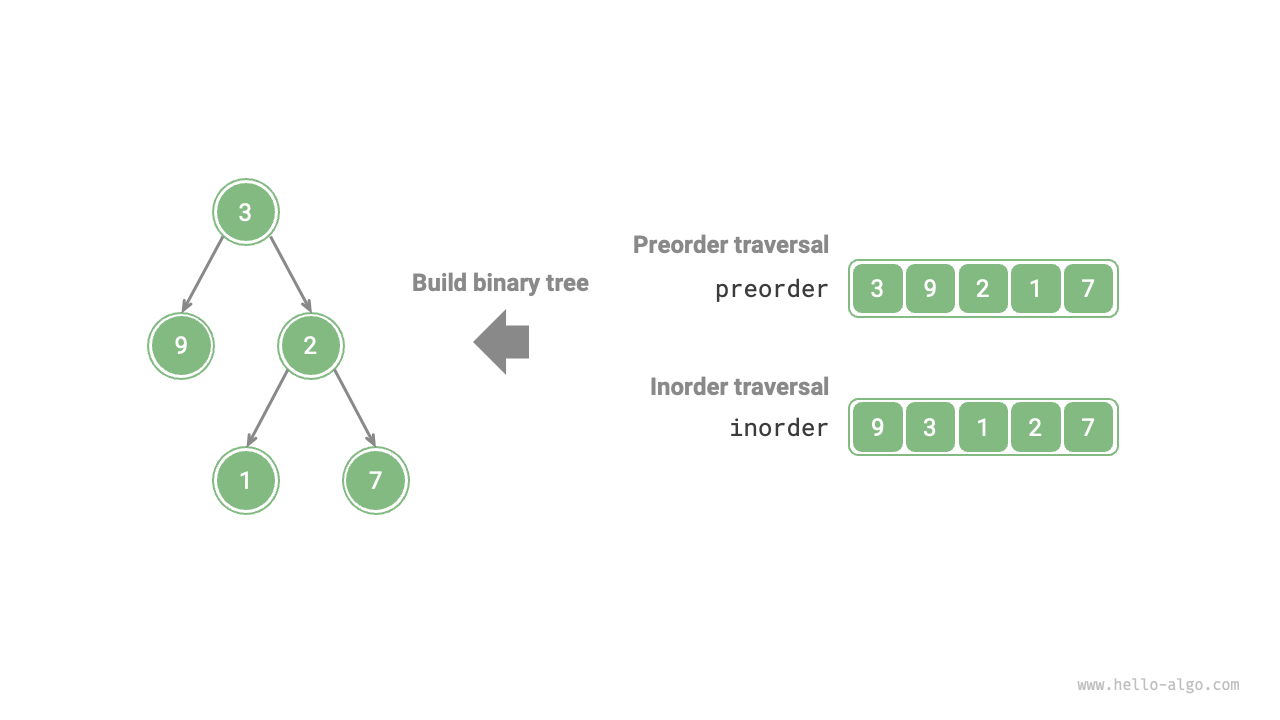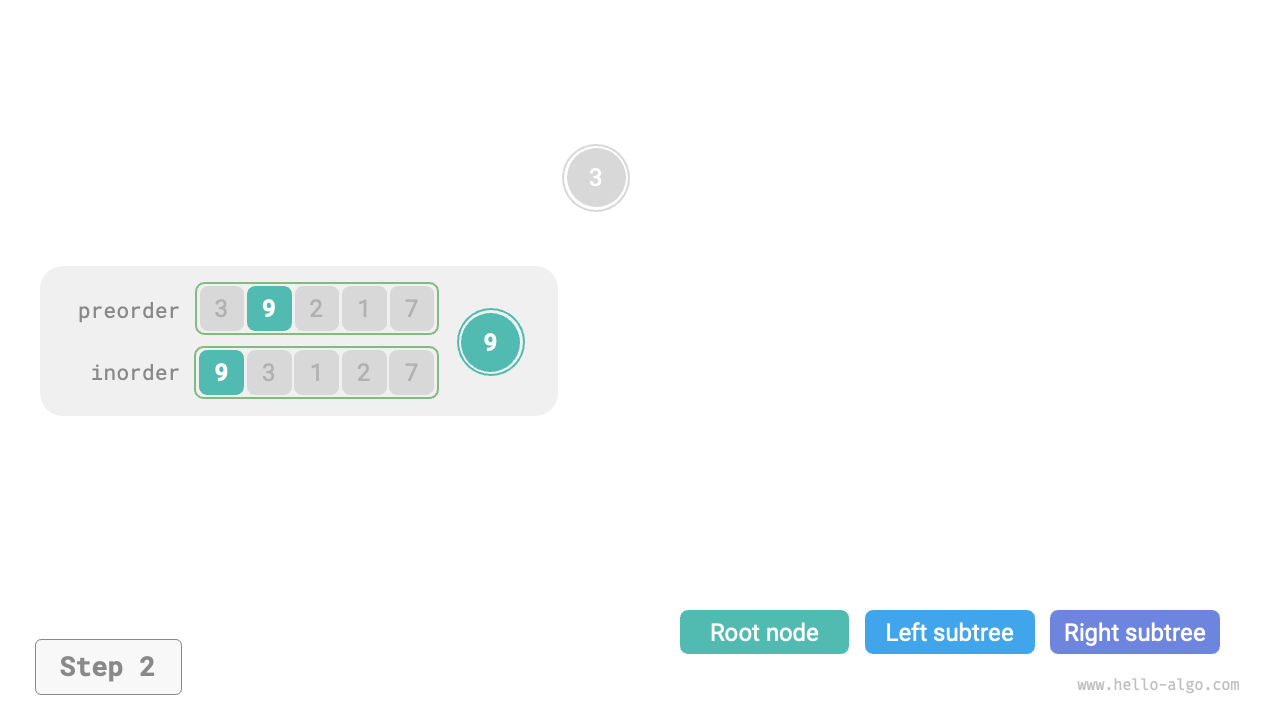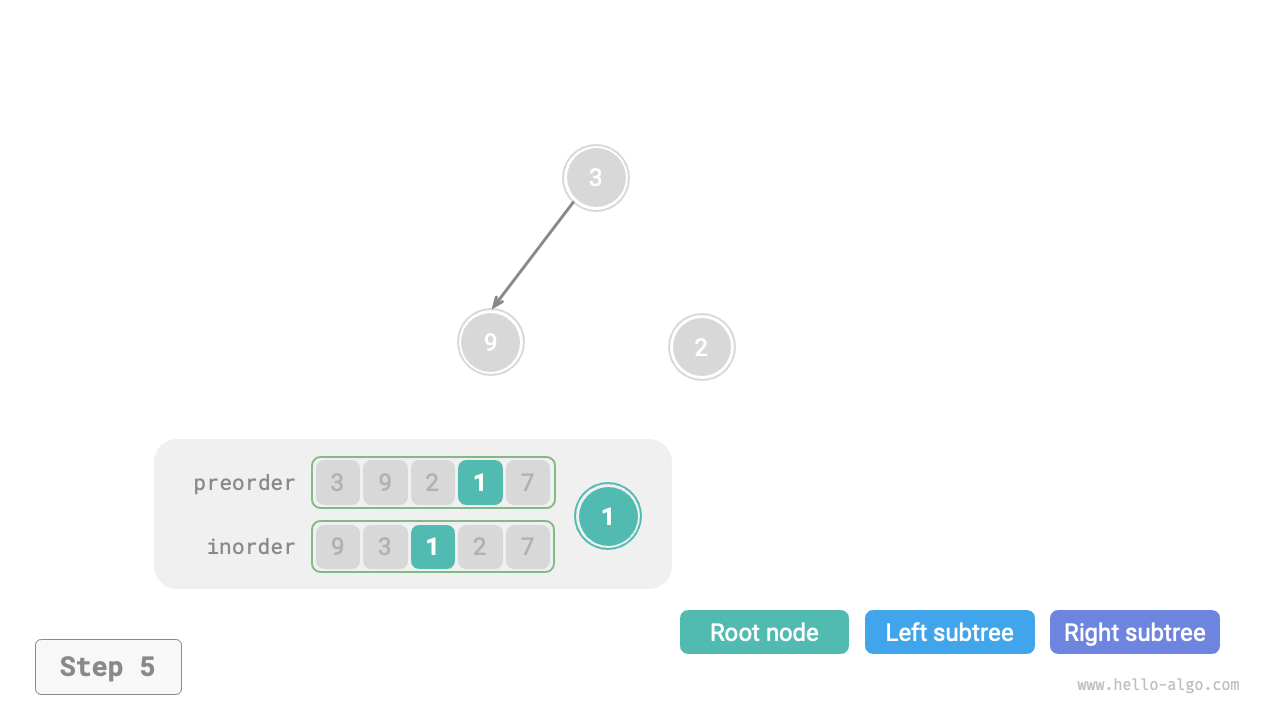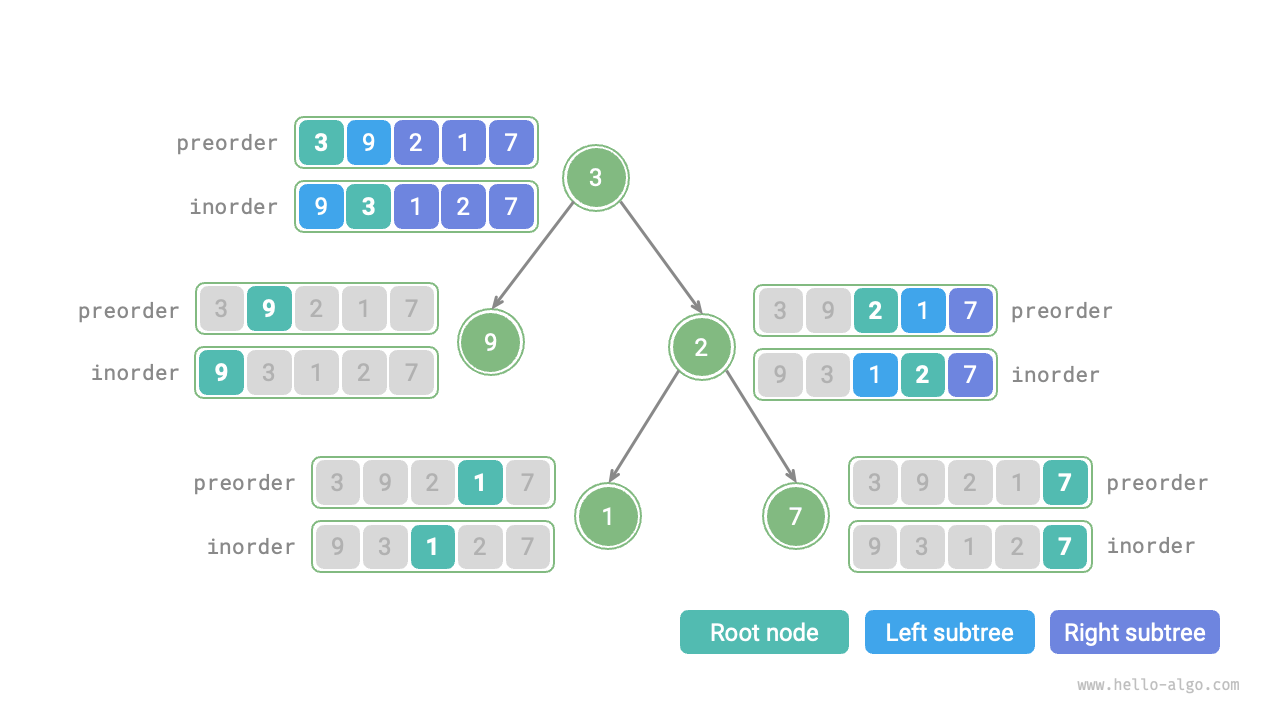12.3 Building a binary tree problem¶
Question
Given the pre-order traversal preorder sequence and the in-order traversal inorder sequence of a binary tree, construct the binary tree and return its root node. Assume there are no duplicate node values in the binary tree (as shown in Figure 12-5).
Figure 12-5 Example data for building a binary tree
1. Determining if it is a divide-and-conquer problem¶
The original problem of building a binary tree from the preorder and the inorder sequences is a typical divide-and-conquer problem.
- The problem can be decomposed: From the perspective of divide-and-conquer, we can divide the original problem into two subproblems—building the left subtree and building the right subtree—plus one operation of initializing the root node. For each subtree (subproblem), we continue applying the same approach, partitioning it into smaller subtrees (subproblems), until reaching the smallest subproblem (an empty subtree).
- The subproblems are independent: The left and right subtrees do not overlap. When building the left subtree, we only need the segments of the in-order and pre-order traversals that correspond to the left subtree. The same approach applies to the right subtree.
- Solutions to subproblems can be combined: Once we have constructed the left and right subtrees (the subproblem solutions), we can attach them to the root node to obtain the solution to the original problem.
2. How to divide the subtrees¶
Based on the above analysis, this problem can be solved using divide-and-conquer. However, how do we use the pre-order traversal preorder sequence and the in-order traversal inorder sequence to divide the left and right subtrees?
By definition, both the preorder and inorder sequences can be divided into three parts:
- Pre-order traversal:
[ Root | Left Subtree | Right Subtree ]. For example, in the figure, the tree corresponds to[ 3 | 9 | 2 1 7 ]. - In-order traversal:
[ Left Subtree | Root | Right Subtree ]. For example, in the figure, the tree corresponds to[ 9 | 3 | 1 2 7 ].
Using the data from the preceding figure, we can follow the steps shown in the next figure to obtain the division results:
- The first element 3 in the pre-order traversal is the value of the root node.
- Find the index of the root node 3 in the
inordersequence, and use this index to splitinorderinto[ 9 | 3 | 1 2 7 ]. - According to the split of the
inordersequence, it is straightforward to determine that the left and right subtrees contain 1 and 3 nodes, respectively, so we can split thepreordersequence into[ 3 | 9 | 2 1 7 ]accordingly.
Figure 12-6 Dividing the subtrees in pre-order and in-order traversals
3. Describing subtree ranges based on variables¶
Based on the above division method, we have now obtained the index ranges of the root, left subtree, and right subtree in the preorder and inorder sequences. To describe these index ranges, we use several pointer variables.
- Let the index of the current tree's root node in the
preordersequence be denoted as \(i\). - Let the index of the current tree's root node in the
inordersequence be denoted as \(m\). - Let the index range of the current tree in the
inordersequence be denoted as \([l, r]\).
As shown in Table 12-1, these variables represent the root node’s index in the preorder sequence and the index ranges of the subtrees in the inorder sequence.
Table 12-1 Indexes of the root node and subtrees in pre-order and in-order traversals
Root node index in preorder |
Subtree index range in inorder |
|
|---|---|---|
| Current tree | \(i\) | \([l, r]\) |
| Left subtree | \(i + 1\) | \([l, m-1]\) |
| Right subtree | \(i + 1 + (m - l)\) | \([m+1, r]\) |
Please note that \((m-l)\) in the right subtree root index represents "the number of nodes in the left subtree." It may help to consult Figure 12-7 for a clearer understanding.
Figure 12-7 Indexes of the root node and left and right subtrees
4. Code implementation¶
To improve the efficiency of querying \(m\), we use a hash table hmap to store the mapping from elements in the inorder sequence to their indexes:
def dfs(
preorder: list[int],
inorder_map: dict[int, int],
i: int,
l: int,
r: int,
) -> TreeNode | None:
"""Build binary tree: Divide and conquer"""
# Terminate when subtree interval is empty
if r - l < 0:
return None
# Initialize root node
root = TreeNode(preorder[i])
# Query m to divide left and right subtrees
m = inorder_map[preorder[i]]
# Subproblem: build left subtree
root.left = dfs(preorder, inorder_map, i + 1, l, m - 1)
# Subproblem: build right subtree
root.right = dfs(preorder, inorder_map, i + 1 + m - l, m + 1, r)
# Return root node
return root
def build_tree(preorder: list[int], inorder: list[int]) -> TreeNode | None:
"""Build binary tree"""
# Initialize hash table, storing in-order elements to indices mapping
inorder_map = {val: i for i, val in enumerate(inorder)}
root = dfs(preorder, inorder_map, 0, 0, len(inorder) - 1)
return root
/* Build binary tree: Divide and conquer */
TreeNode *dfs(vector<int> &preorder, unordered_map<int, int> &inorderMap, int i, int l, int r) {
// Terminate when subtree interval is empty
if (r - l < 0)
return NULL;
// Initialize root node
TreeNode *root = new TreeNode(preorder[i]);
// Query m to divide left and right subtrees
int m = inorderMap[preorder[i]];
// Subproblem: build left subtree
root->left = dfs(preorder, inorderMap, i + 1, l, m - 1);
// Subproblem: build right subtree
root->right = dfs(preorder, inorderMap, i + 1 + m - l, m + 1, r);
// Return root node
return root;
}
/* Build binary tree */
TreeNode *buildTree(vector<int> &preorder, vector<int> &inorder) {
// Initialize hash table, storing in-order elements to indices mapping
unordered_map<int, int> inorderMap;
for (int i = 0; i < inorder.size(); i++) {
inorderMap[inorder[i]] = i;
}
TreeNode *root = dfs(preorder, inorderMap, 0, 0, inorder.size() - 1);
return root;
}
/* Build binary tree: Divide and conquer */
TreeNode dfs(int[] preorder, Map<Integer, Integer> inorderMap, int i, int l, int r) {
// Terminate when subtree interval is empty
if (r - l < 0)
return null;
// Initialize root node
TreeNode root = new TreeNode(preorder[i]);
// Query m to divide left and right subtrees
int m = inorderMap.get(preorder[i]);
// Subproblem: build left subtree
root.left = dfs(preorder, inorderMap, i + 1, l, m - 1);
// Subproblem: build right subtree
root.right = dfs(preorder, inorderMap, i + 1 + m - l, m + 1, r);
// Return root node
return root;
}
/* Build binary tree */
TreeNode buildTree(int[] preorder, int[] inorder) {
// Initialize hash table, storing in-order elements to indices mapping
Map<Integer, Integer> inorderMap = new HashMap<>();
for (int i = 0; i < inorder.length; i++) {
inorderMap.put(inorder[i], i);
}
TreeNode root = dfs(preorder, inorderMap, 0, 0, inorder.length - 1);
return root;
}
Figure 12-8 shows the recursive process of building the binary tree. Each node is created during the "descending" phase of the recursion, and each edge (reference) is formed during the "ascending" phase.
Figure 12-8 Recursive process of building a binary tree
Each recursive function's division of the preorder and inorder sequences is illustrated in Figure 12-9.
Figure 12-9 Division in each recursive function
Assuming the binary tree has \(n\) nodes, initializing each node (calling the recursive function dfs()) takes \(O(1)\) time. Therefore, the overall time complexity is \(O(n)\).
Because the hash table stores the mapping from inorder elements to their indexes, it requires \(O(n)\) space. In the worst case, if the binary tree degenerates into a linked list, the recursive depth can reach \(n\), consuming \(O(n)\) stack space. Hence, the overall space complexity is \(O(n)\).












